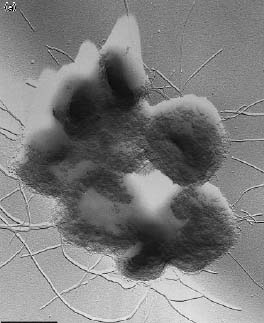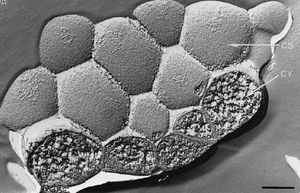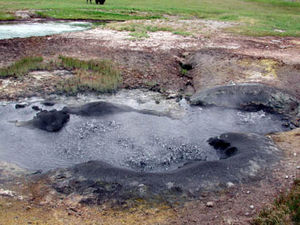Thermosphaera: Difference between revisions
No edit summary |
|||
| Line 32: | Line 32: | ||
''Thermosphaera'' are found mainly in sulfaric pools, where they thrive on the extreme temperatures. In terms of research and economic significance, learning more about these organisms and their properties may help advancements in biotechnology. | ''Thermosphaera'' are found mainly in sulfaric pools, where they thrive on the extreme temperatures. In terms of research and economic significance, learning more about these organisms and their properties may help advancements in biotechnology. | ||
[[Image:Obsidians-Pool.jpg|thumb|300px|right|Obsidian's Pool in Yellowstone National Park, a habitat typical of ''Thermosphaera''. Image from [http://www. | [[Image:Obsidians-Pool.jpg|thumb|300px|right|Obsidian's Pool in Yellowstone National Park, a habitat typical of ''Thermosphaera''. Image from [http://www.microbiology.ncsu.edu/JWB/JWB.html James W. Brown, North Carolina State University.]]] | ||
==References== | ==References== | ||
Revision as of 20:03, 16 June 2006
|
NCBI: |

Classification
Higher order taxa:
Archaea, Crenarchaeota, Thermoprotei, Desulfurococcales, Desulfurococcaceae
Species:
Thermosphaera aggregans
Description and Significance
The Thermosphaera are a group of prokaryotic organisms which have been discovered in extremely hot environments such as sulfur springs, volcanoes, and magma pools. Isolates of thermosphaera were first identified in 1998 from the Obsidian Pool in Yellowstone National Park.
Genome Structure
Sequencing the 16S rRNA of Thermosphaera showed that this isolate was a member of the group Crenarchaeota and closely related to Staphylothermus and Desulfurococcus.
Cell Structure and Metabolism

Cells of Thermosphaera are cocci (spherical) and form grape-like aggregates during the exponential growth phase. In the late logarithmic and stationary growth phases, smaller groups, including some single cells, were visible. Aggregates were shown to have several flagella; single cells could have as many as eight. The cell envelope is an amorphous layer covering a cytoplasmic membrane. Temperatures exceeding 92 C inhibits growth, as does sulfur and hydrogen. Thermosphaera cells are heterotrophic, processing energy from yeast.
Ecology
Thermosphaera are found mainly in sulfaric pools, where they thrive on the extreme temperatures. In terms of research and economic significance, learning more about these organisms and their properties may help advancements in biotechnology.

